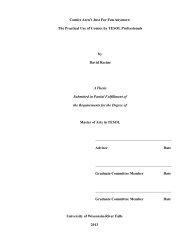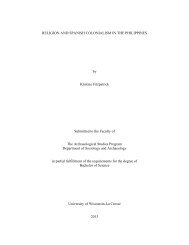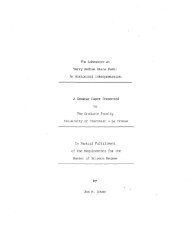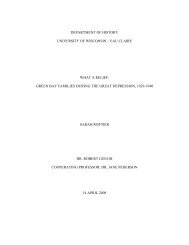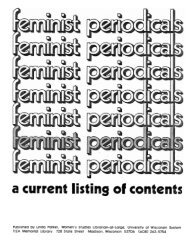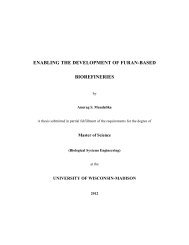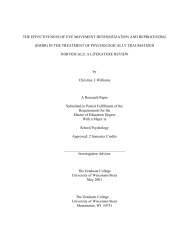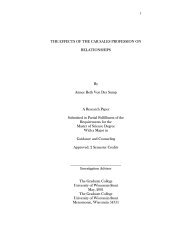1 CONFRONTS THE TEXTBOOK.. - MINDS@UW Home - University ...
1 CONFRONTS THE TEXTBOOK.. - MINDS@UW Home - University ...
1 CONFRONTS THE TEXTBOOK.. - MINDS@UW Home - University ...
You also want an ePaper? Increase the reach of your titles
YUMPU automatically turns print PDFs into web optimized ePapers that Google loves.
Orthodox Women (Rutgers, 1991) is one of the few cita-<br />
tions to works ostensibly about Israeli women, but the<br />
book in fact deals with American Jewish women. A bet-<br />
ter choice on Israeli women would have been the article<br />
by Dafna Izraeli and personal essays by women workers<br />
in the "Work Women Do" section of Calling the Equal-<br />
ity Blu8 Women in Israel, edited by Barbara Swirski<br />
and Marilyn P. Safir (Pergamon, 199 1). These essays are<br />
just the type Ghorayshi wanted to include.<br />
Nevertheless, I recommend Women and Work in<br />
Developing Countries as a very good resource to anyone<br />
interested in finding a variety of materials on the sub-<br />
ject.<br />
Barbara Littman and Michael Ray, <strong>THE</strong> WOMEN'S<br />
BUSINESS RESOURCE GUDE: A NATIONAL DI-<br />
RECTORY OF OVER 600 PROGRAMS, RESOURCES<br />
A m ORGANI24TIONS TO HELP WOMEN START<br />
OR -AND A BUSINESS. Eugene, OR: The Resource<br />
Group, 1994 (P.0. Box 25505, Eugene, OR 97402). 13 lp.<br />
index. $21.95. ISBN 1-884565-01-8.<br />
Women currently own 30 percent of all businesses<br />
in the United States, a number expected to rise to 40-50<br />
percent by the year 2000, according to the Small Busi-<br />
ness Administration's Status Report to Congress, Statis-<br />
tical Information on Women in Business (1990). Accord-<br />
ing to Littman and Ray (a married couple with back-<br />
grounds in small business, marketing, education, writ-<br />
ing, and design), women-owned businesses grow more<br />
slowly than those started by men, although their long-<br />
term success rate is dramatically better. Citing Manage-<br />
ment Review March 1992, they say that 75 percent of<br />
women-owned businesses succeed, compared to 20 per-<br />
cent for "all businesses." Yet, they were struck by how<br />
few businmomen they came in contact with were aware<br />
of the many resources available to women in business,<br />
and they therefore decided to compile this Guide.<br />
The Guide covers federal, state, and private resources<br />
of information and training, technical assistance and<br />
counseling programs. Basic information is provided about<br />
each resource, and in some cases a more detailed "pro-<br />
file" of a participant follows. They also devote one of<br />
their five chapters to "Selling to the Gwenunent" to<br />
encourage women entrepreneurs to compete for govern-<br />
ment contracts, calling special attention to "small busi-<br />
ness set-asides," a procurement regulation requiring that<br />
government purchases of $25,000 or less be purchased<br />
from small businesses. Another chapter describes pro-<br />
fessional and business associations of women along with<br />
general business associations. Almost half the book is a<br />
dimtory of national, regional, and state offices of vari-<br />
ous business-related governmental agencies. Five pages<br />
of "Books For and About Women in Business" published<br />
since 1988 lead to additional resources.<br />
The Women's Business Resource Guide is graphi-<br />
cally pleasing and easy to browse. It is a good choice for<br />
public libraries. The state-by-state listings of the offices<br />
of the same federal agencies seem a bit superfluous, how-<br />
ever. A description of each agency with offices through-<br />
out the United States would have been sufficient, with a<br />
note "Oflices in each state. Consult federal listings in<br />
your local phone book for the office in your area." I doubt<br />
this would have stymied would-be entrpreneurs. But then<br />
the book would have been considerably shorter, and per-<br />
haps too short to publish.<br />
Rosemary M. Canfield Reisman and Christopher J.<br />
Canfield, CONTEMPDR4RY SOU<strong>THE</strong>RN WOMEN<br />
FICTION WRITERS: ANANNOTATED BIBLIOGRA-<br />
PHY. Metuchen, NJ: Scarecrow Press, 1994. 225p. in-<br />
dex. $32.50, ISBN 0-8108-2832-4.<br />
Each word in the title is significant to understand-<br />
ing who is included (and who isn't) among the twenty-<br />
eight authors in this bibliography. "Contemporary" is<br />
defined as currently or recently producing works of fic-<br />
tion, thus excluding Eudora Welty. "Southern" means<br />
writers born in the South, even if they live elsewhere and<br />
disparage their birthplace (ex.: Alice Adams). "Fiction"<br />
allows novelists and short story writers in, but not poets<br />
or essayists, and "women writers" include those who es-<br />
chew the label. The realities of annotating are such that<br />
the phrase "annotated bibliography" presages selectivity<br />
over comprehensiveness, and though the work bears a<br />
1994 publication date, citations end with 1991. Because<br />
the authors also wanted to balance the amount of mate-<br />
rial presented on each writer, citations on well-researched<br />
writers like Alice Walker come mainly fiombooks, while<br />
Vicki Covington's listing include periodicals and news-<br />
paper articles. Since the authors clearly enunciate this<br />
poiicy in their introduction, readers should have no prob-<br />
lem interpreting the level of coverage.<br />
One pmblem I have with the book, however, is one I<br />
find much too often with reference works on women. I<br />
see articles cited from Saturday Review, Critique: Stud-<br />
ies in Modern Fiction, The New York Rmes Book Re-



